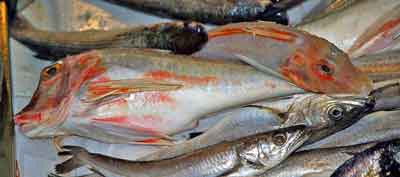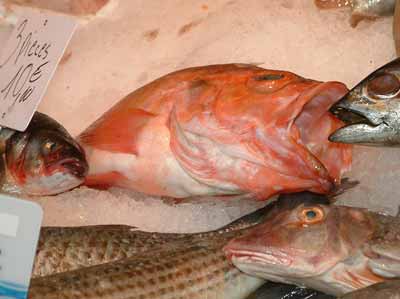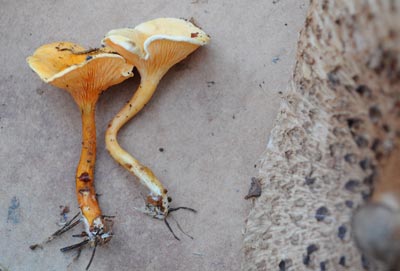
Red gurnard. Gurnards are strange-looking, scaly, spiky, bottom-feeding fish which use the three bottom rays of their pectoral fins to "feel" the sea bed. They have firm-textured white meat with a mild flavour. They are rich in protein, iodine and phosphorus. The red gurnard is the most attractive member of the family with pinkish-red colour and the finest flavour of the gurnards. They are all bony and tend to dryness so they are best served with a sauce. Small ones are excellent in soup. Red or grey mullet (US: striped mullet) can generally be subsituted for it, and are usually better.
A Galician name for rascasse or black scorpion fish. This is a smaller and less glamourous fish than the red scorpion fish, and is well camouflaged, in blacks, greens and browns. However, it is just as useful in a bouillabaisse.

A Galician name for rascasse, or red scorpion fish. A fish similar to a gurnard, mainly red or orange in colour, with a huge, ugly head and poisonous spiny dorsal fins. The large scaly head is inedible. However, this well-flavoured fish is most famous as an indispensable ingredient of bouillabaisse. It is found in deep waters throughout the Mediterranean and as far north as Brittany. Large fish may be baked, providing firm white flesh.

Brown shrimp. A small, common shrimp which grows up to 6 cm (2½ inches) long, has a soft shell and turns greyish-brown when cooked. It is found on sandy shores. It has excellent flavour.
Pestle puffball. A type of mushroom not generally considered to be edible but can be eaten when young.

False chanterelle. As its name implies, this masquerades as a chanterelle but, instead of the egg yellow of the chanterelle, this is a darker orange and sometimes with a graded cap, dark at the centre and becoming lighter towards the edges. The false chanterelle is found in woodland, particularly under pines. It is edible, but is rather bitter and tough and may cause indigestion. It is easily confused with other mushrooms which are poisonous, so especial care must be taken.